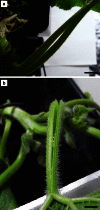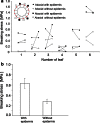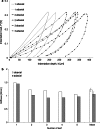Are trichomes involved in the biomechanical systems of Cucurbita leaf petioles?
- PMID: 26306605
- PMCID: PMC4605971
- DOI: 10.1007/s00425-015-2388-z
Are trichomes involved in the biomechanical systems of Cucurbita leaf petioles?
Abstract
Trichomes are involved in petiole movement and likely function as a part of the plant biomechanical system serving as an additional reservoir of hydrostatic pressure. The large, non-glandular trichomes on Cucurbita petioles occur across collenchyma strands. Time-lapse imaging was used to study the leaf reorientation of Cucurbita maxima 'Bambino' plants placed in horizontal position. The experiment comprised four variants of the large non-glandular petiole trichomes: (1) intact, (2) mechanically removed, (3) dehydrated, and (4) intact but with longitudinally injured petioles. Isolated strands of collenchyma with intact epidermis or epidermis mechanically removed from the abaxial and adaxial sides of the petiole were subjected to breaking test. The stiffness of the non-isolated tissue with intact epidermis was measured using the micro-indentation method. Petioles without trichomes did not exhibit tropic response, and the dehydration of trichomes slowed and prevented complete leaf reorientation. Isolated strands of collenchyma showed no correlation between strength values and position on the petiole. However, strands of collenchyma with epidermis exhibited a significantly greater strength regardless of their position on the petiole. The indentation test showed that non-isolated collenchyma is stiffer on the abaxial side of the petiole. Trichomes from the abaxial side of the petiole were larger at their base. The application of the 'tensile triangles method' revealed that these trichomes had a biomechanically optimized shape in comparison to the adaxial side. We conclude that trichomes can be involved in plant biomechanical system and serve as an additional reservoir of hydrostatic pressure that is necessary for maintaining petioles in the prestressed state.
Keywords: Collenchyma; Epidermis; Plant biomechanics; Shape optimization; Tropic response.
Figures











References
-
- Arthur JC. Various forms of trichomes of Echinocystis lobata. Bot Gaz. 1881;6:180–183. doi: 10.1086/325453. - DOI
MeSH terms
LinkOut - more resources
Full Text Sources
Other Literature Sources

